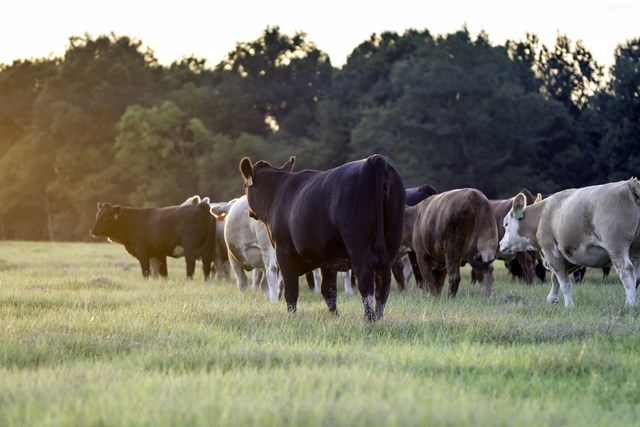The general approach of these twice-monthly posts is to take a step back and review the big picture cattle price trends.
Today let’s take a quick look at what we’re watching and the latest take on it.
- A solid low for the long-term cattle price cycle is not yet in place.
We tend to pay attention to the long-term cyclic price swings.
What’s new in terms of these long-term cycles, measured in terms of years and decades?
A major cycle peak occurred in late 2014. That was a peak of not just the expansion/liquidation phase of an approximate 10 to 12-year cycle. It was also a macro-economic peak of greater importance in the context of several decades.
The market cliff-dropped from that peak and hit a hard, rocky bottom in the fall of 2016.
It then moved up for several months into May of 2017. Now it is weakening off again.
We expect moderate rallies and dips for several months. Although the fall low in 2016 may have represented the lowest price for the current 10-year period, there is still a risk of somewhat similarly low prices as the market works its way through the next three years.
Point is, the market may yet have to bear the brunt of the current beef and meat expansion phase that is ongoing. A solid low for the herd expansion cycle is not yet firmly in place. Meanwhile, as warned in the past, don’t look for anything remotely close to the bull market peak of 2014, for many years.
- Short-term price cycles allow for a bounce following recent losses
These blogs also update you on the intermediate-term cyclic swings measured in terms of weeks and months.
What’s happening on this scale?
After the October 2016 low, the pendulum swung higher into May of 2017. Now it is swinging the other way. Prices have trended generally and broadly lower since May.
Cash markets are getting hit harder than futures, because for months futures were underpriced relative to cash markets.
Some markets may be putting in seasonal lows now but some have more to lose. Although there is some evidence of bottoming action for the three-month downtrend, there’s not a clear line-up of bullish signals that strongly signal that important lows are definitely in place.
- Beef is commanding a strong premium to pork and poultry. This will continue.
We also pay attention to inter-commodity relationships, such as the spread of cattle/beef over hogs/pork.
In this regard, we have said before that the cattle market will, on average, maintain a wider spread over hogs than it did during the mid 1900s through into the 2000 to 2011 time frame, but that the extremely wide spread seen in 2014 won’t be the norm.
What’s the primary reason for expecting a continuing strong premium by cattle and beef? The beef business is not overproducing and has been growing the past decade at a far less rapid pace than pork and chicken.
- Relationship between cattle and feed prices should calm down, somewhat.
It is useful to monitor the grain markets and their price levels in relation to cattle.
Obviously the price of grain is an important component in the profitability of the cattle business.
In this regard it’s helpful to check in now and then on the cattle:corn ratio.
It reached an extreme low when corn soared in 2008 and again in 2012. During those years, the cattle:corn ratio spent a long time at one of the longest, most extreme lows in history.
One extreme creates an opposite extreme so after that, the ratio rose to a major high when cattle soared in 2014, early 2015 while at the same time corn was down in the dumps.
In the five-year period ahead, we don’t foresee the same wild extremes as witnessed in that 2008 through 2015 timeframe.
That doesn’t mean there won’t be ups and downs in grain and livestock prices.
You can bet that a roller coaster ride of dear meat vs cheap grain and the swings will continue in the years and decades ahead, even if it’s not as wild as the past 10 years.
If you want to be part of this business you have to be ready to stay in the saddle during the wild times, without being bucked out of business by expensive grain/low livestock.
It’s part of the business, part of the game.
- North American meat production will keep trending up in 2018. Plan accordingly.
We try to avoid getting too caught up in the daily and weekly noise that circulates in this commodity market just as it does in all others.
Focusing more on the basic, underlying fundamental trends, one basic factor to bear in mind is a simple and obvious one: Meat production in North America is trending up.
Firm to rising export and domestic demand has been offsetting a good deal of the rising supply increases the past year and will probably keep doing so, but there will be times when the beef demand side doesn’t fully counterbalance the impact of rising meat supplies.
A related key force, that’s part of this: The last USDA inventory report proved ranchers are throttling back on heifer retention and therefore herd expansion plans. This was covered in a previous blog post.
The smash down in cattle prices in late 2016 was motivation for that. Drought in key areas of the Northern Plains will ensure it shows up in the next inventory report was well.
Point is, you’re still looking at more expansion ahead. It’s just not flat-out aggressive.
- Cattle markets don’t operate in a vacuum. The outlook hinges on many factors, including some that are outside agriculture.
Part and parcel of the broad underlying backdrop is geopolitical uncertainty. Trade issues put some uncertainty into the business and we keep an eye on the big picture in this regard.
In 2008 all markets including cattle smashed lower during the so-called credit crunch that bottomed out late that year and early 2009. That had a big impact on a lot of people’s farming and ranching businesses. It’s hard to see earth-moving events like that coming and we can’t promise we will see the next surprise waiting around the corner.
It’s worth reminding ourselves that we are doing business within a long-lasting, broad-based economic recovery and stock market boom. The rising tide is about 8 ½ years old. By the standards of historic economic growth phases, that’s a long time. This won’t last forever. No sign today that it’s ready to turn down, but when it does, it could have broad-based implications on beef demand, agricultural commodity prices and on the agriculture industry.
By John DePutter & Dave Milne, DePutter Publishing, Ltd
Brought to you in partnership by:



